The Kids Are More Than All Right: Mad Max Beyond Thunderdome on Blu-ray
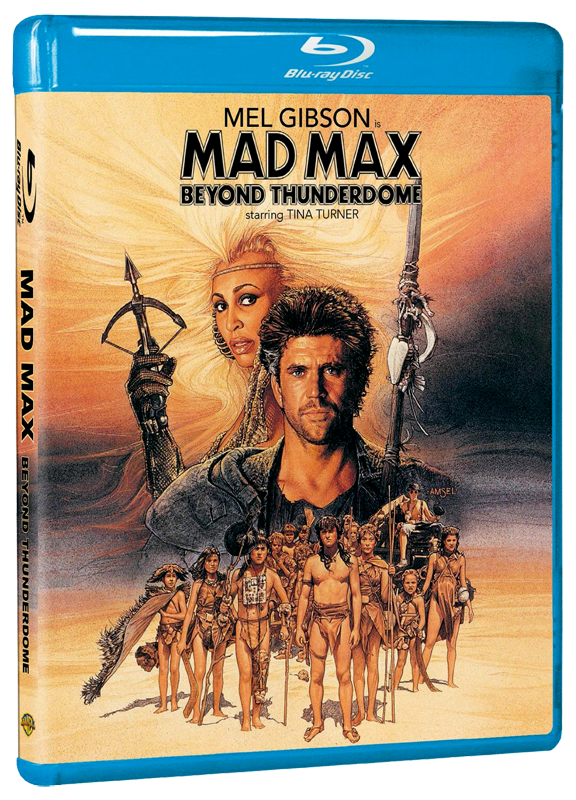 Mad Max Beyond Thunderdome (1985)
Mad Max Beyond Thunderdome (1985)
Directed by George Miller and George Ogilvie. Starring Mel Gibson, Tina Turner, Helen Buday, Frank Thring, Bruce Spence, Robert Grubb, Angelo Rossitto, Angry Anderson, George Spartels, Edwin Hodgeman.
“This you knows. The posts on Black Gate travel fast, and time after time I’ve done the tell. But this ain’t one body’s tell. This is the tell of us all who love the Mad Max franchise. And you gotta listen to it and remember. ‘Cause what you hear today, you gotta tell the newborn tomorrow. I’s looking behind us now, into history-back. I sees those of us who got the luck and started the haul for hi-def. And I remember how it led us here and we were heartful ‘cause we saw the pan-and-scan VHS of what was. And we knewed we got it straight.”
If it weren’t for my aversion to camping and having to use porta-potties, I would attend Wasteland Weekend every year, a “360° post-apocalypse environment” held each September in the Southern California desert for other Mad Maxians. I’m that much of a fan. I prefer an air-conditioned theater and a marathon of the three films (to which a fourth will be added next year) over risking a Gila monster bite, however.
Now I can hold the movie marathon in my less-well air-conditioned apartment — with indoor plumbing and absolutely no Gila monsters! — because Mad Max Beyond Thunderdome made its debut on Blu-ray last week, completing the trilogy in hi-def.
For both fans and the general public, Mad Max Beyond Thunderdome generally ranks below the other two movies, Mad Max (1979) and The Road Warrior/Mad Max 2 (1981). The third film plays a lot nicer with other children than its predecessors: the low-budget exploitation biker/revenge flick of Mad Max and the violent action spectacle of The Road Warrior took a Spielbergian mid-‘80s shift that’s positively heartwarming. This was when the series went from an earned “R” rating to a family-friendly PG-13, and its rough wasteland-traversing hero came to the rescue of a clan of K-through-12s.
The simplistic comparison is to call Mad Max Beyond Thunderdome the Conan the Destroyer of its franchise: “the kid-friendly cheesy one.” But this comparison only applies to the level of violence. The drop in quality is nowhere near that between the two Dino de Laurentiis Conan movies. Beyond Thunderdome, viewed almost thirty years after its premiere, doesn’t feel like a horrible betrayal of what came before, but a natural outgrowth of its setting and storytelling. Yes, it’s still the third best of the original trilogy, but consider how high the bar was already set: there’s no shame having to stretch a bit and not quite reach it. Mad Max Beyond Thunderdome is a worthwhile movie that repays repeat viewings. Seeing it now on Blu-ray makes me realize that I adore it — and not in spite of the passel of children, but because of them.
When I previously wrote about the three Mad Max films after a marathon screening, I noted each movie appears to take place in a different world. The background is never the same: Mad Max occurs in a tottering dystopia, The Road Warrior in the aftermath of a giant war and global fuel shortage, but only in Mad Max Beyond Thunderdome does the wreck of the world happen via mushroom clouds and fallout — “pocks-a-clypse!” The world is a much stranger place, turning toward a setting that borders on sword-and-sorcery.
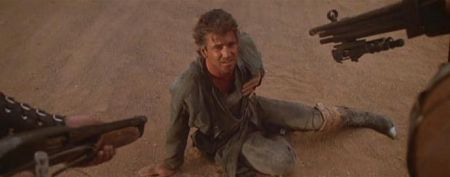 The first time we see Max (whose name is spoken only once during the running time), he isn’t blazing down an empty two-lane blacktop in a turbo-charged car, but dragging a dead vehicle across sand dunes with a team of camels. In fact, paved roads never appear anywhere in the film. Consider that: a sequel to a movie called The Road Warrior and an earlier movie about a highway policeman has no roads in it. (Unless you count the railroad used for the climactic chase scene.)
The first time we see Max (whose name is spoken only once during the running time), he isn’t blazing down an empty two-lane blacktop in a turbo-charged car, but dragging a dead vehicle across sand dunes with a team of camels. In fact, paved roads never appear anywhere in the film. Consider that: a sequel to a movie called The Road Warrior and an earlier movie about a highway policeman has no roads in it. (Unless you count the railroad used for the climactic chase scene.)
When Max arrives at Bartertown, one of the settlements trying to grope toward a restored civilization, we drop farther into the fantastic. Remove a few gunpowder weapons and industrial machines, and this might be Shadizar from Conan the Barbarian. Cultures and costumes collide, the law is decided through gladiatorial contests, the ruler sits in a silver tower above her subjects, and beneath the bustle of trade is a hellish underworld overseen by an imp and a giant. Where The Road Warrior is based on the classic film Western for most of its backdrop, Mad Max Beyond Thunderdome stirs up the frontier town with thick amounts of science-fantasy.
What most people remember about the film is the gladiator fight inside the titular arena where “two men enter, one man leaves.” Max, operating as an agent for Bartertown’s leader Aunty Entity (Tina Turner, oddly subdued for this nutty world), fights in Thunderdome against Blaster, the towering enforcer who works as the muscle half of the duo who controls Bartertown’s underground pig-fueled methane factory. Co-director George Miller must have known it was hopeless to attempt to top the tanker chase conclusion to The Road Warrior — one of the greatest vehicular action scenes in history — so he devised the unusual Thunderdrome fight as the movie’s set-piece. The sequence feels less groundbreaking today when wirework stunt battles have become a cliché in Hollywood. But the choreography of two combatants flipping around on bungee cords to reach an assortment of weapons is still a great out-there idea at home with the increasingly weird world of the Mad Max-a-clypse. The action scene meant to stand in for the chase from The Road Warrior, involving a train from Bartertown trying to outrace Aunty Entity’s legion of odd vehicles (including a great cow-hide car), is less interesting and seems aware of it.
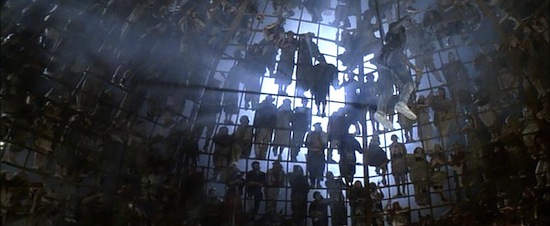 But it’s the children who make the film work together as a thematic piece, instead of just an adventure flick with a memorable action scene. “The Tribe,” the post-apocalypse version of Peter Pan’s Lost Boys, is more the core of the movie than Thunderdome. (Aren’t we trying to get beyond Thunderdome anyway?) These descendants of airplane crash survivors live in an oasis sunk in a crack in the desert, where they await the return of “Captain Walker,” who they believe will lead them to the idyllic “Tomorrow-morrow Land.” Max ends up in the children’s care — and they assume he is Captain Walker come as their Messiah. But at first Max refuses to help them.
But it’s the children who make the film work together as a thematic piece, instead of just an adventure flick with a memorable action scene. “The Tribe,” the post-apocalypse version of Peter Pan’s Lost Boys, is more the core of the movie than Thunderdome. (Aren’t we trying to get beyond Thunderdome anyway?) These descendants of airplane crash survivors live in an oasis sunk in a crack in the desert, where they await the return of “Captain Walker,” who they believe will lead them to the idyllic “Tomorrow-morrow Land.” Max ends up in the children’s care — and they assume he is Captain Walker come as their Messiah. But at first Max refuses to help them.
The Tribe is the “answer civilization” to Bartertown. They are parallel societies attempting to forge a future. The first half of the film stars Bartertown and its population of violent and cynical beasts. The congested city of trade feels like a place Max might exist in, since he’s become a cynical beast himself. But Max initially has nothing to offer Bartertown, no goods and no services. “You got nothing to trade, you’ve got no business in Bartertown,” Alfred Hitchcock (credited as “The Collector” and played by Frank Thring*) informs Max when he tries to enter the settlement. Max only gets inside by making a deal with Aunty Entity to pull a political assassination. And he won’t go through with that either because Max isn’t quite the beast he thought he was. But, “Bust a deal, face the wheel!”: Bartertown kicks Max out into the sand.
[*Frank Thring would later play an Alfred Hitchcock-like director in Howling III. His resemblance in looks and voice to the famous director is uncanny.]
Then the children find him, and Max is inside the other growing civilization — one that is a genuinely new culture. The children, born after the nuclear holocaust and unaware of its details, are developing an oral society with new myths based on the shreds of evidence of the world that existed before them. The details in these sequences — a confluence of script, performances, costumes, and props — create a believable original culture. The language of the children is particularly rich, although tricky to follow at first. Like the slang in A Clockwork Orange, it takes some effort to adjust to how the children have repurposed words and ideas, but it’s worth the work.
The dialogue of the Tribe is endlessly quotable. Here is a good sample of their argot from a scene where one of the oldest, Savannah Nix, tries to convince the others to follow her on a trek from their oasis after Max’s existence proves the desert can be crossed:
SAVANNAH NIX: That’s the trick of it. Who’s coming?
JOANNA GOANNA: Across the Nothing? Don’t you ‘member? When you’s finded him, he were half jumped by Mr. Dead.
SAVANNAH NIX: Nobody’s saying it ain’t a hard slog. We knows that now. But if we wants the knowing and the doing of things, there ain’t no easy ride.
SLAKE M’THIRST: There ain’t no knowing and there ain’t no doing! There ain’t no skyraft and there ain’t no sonic. You slog out there to nothing!
SAVANNAH NIX: Whoever’s got the juice, track with us.
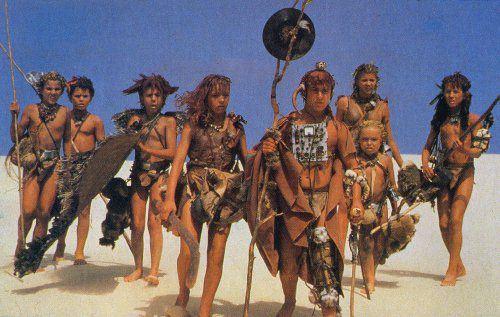 In The Road Warrior, Max helps out a human settlement trying to create a better world for themselves, a re-start of society. But the people of the oil-pumping compound are almost all adults who remember what the world was like before civilization went to dust. The Tribe, however, has no memories of anything from before the plane crash that left their families stranded in the “Nothing,” surrounded by “Mr. Dead.” They are a new generation separated from the expectations of the old. They have a hope for a future that isn’t controlled by the past. Their use of language is part of the rebuilding of society: it’s an effect of their oral culture and the artifacts they have, but also a microcosm of a society re-forming based on detachment from previous meanings.
In The Road Warrior, Max helps out a human settlement trying to create a better world for themselves, a re-start of society. But the people of the oil-pumping compound are almost all adults who remember what the world was like before civilization went to dust. The Tribe, however, has no memories of anything from before the plane crash that left their families stranded in the “Nothing,” surrounded by “Mr. Dead.” They are a new generation separated from the expectations of the old. They have a hope for a future that isn’t controlled by the past. Their use of language is part of the rebuilding of society: it’s an effect of their oral culture and the artifacts they have, but also a microcosm of a society re-forming based on detachment from previous meanings.
Oh, have I mentioned the kids are just fantastic characters? Each one with a special idiosyncrasy, identifiable even if you don’t always catch their individual names, like Scrooloose, Savannah Nix, Gekko, and Slake M’Thirst. The children all give performances of great naturalism. (Admittedly, the “child” with the largest role, Helen Buday as Savannah Nix, is only six years younger than Mel Gibson.) Repeat viewings of the film uncover subtle emotional veins among their scenes. The most moving sequence has two of the children, Mr. Skyfish (Mark Spain) and Joanna Goanna (Justine Clarke), listening to a record and hearing a French tutor ask them to repeat the phrase, “I am going home.”
Max doesn’t turn into the immediate savior of the Tribe: he prefers to hole up in the oasis and stay there, and to hell with the rest of the world. And even after he changes his mind and helps the children who chose to leave the oasis, the movie does not offer him any idyllic happy ending. Instead, he receives a similar fate of isolation that he did in The Road Warrior. The idea of “Mad Max helping out a bunch of kids!” in practice is no different than what he did for the people in the compound in the second movie. The Tribe is the next logical step in civilization’s regrowth, and Max is again excluded from it — in a way that recalls the ending of John Ford’s classic The Searchers. The scavenger sacrifices for the good of civilization, yet has no place in it.
George Miller, who directed both previous Mad Max films, shares directorial credit with George Ogilvie on Beyond Thunderdome, and this is important for the scenes with the Tribe. Miller originally intended to direct the whole film, but after his producing partner Byron Kennedy died in a helicopter crash while scouting locations, Miller lost some of his enthusiasm for the project. He then brought on Ogilvie, an award-winning theater director who had worked with Miller on a television mini-series, to co-direct. Although the division of work isn’t clear, Ogilvie was apparently hired to handle the drama-heavy scenes while Miller attended to the action parts. The Bartertown scenes certainly feel like Miller directed them, while the scenes with the Tribe have the mark of a director familiar with stage work. The children are engaged in a form of theater; when Savannah Nix does the “tell” of their history, using a frame woven from sticks that imitates a television monitor, the children work together to create an experimental theater piece. If the children’s scenes are indeed mostly the work of Ogilvie, he did an exceptional job. He gets remarkable performances from the young actors, some who don’t look much older then three or four.
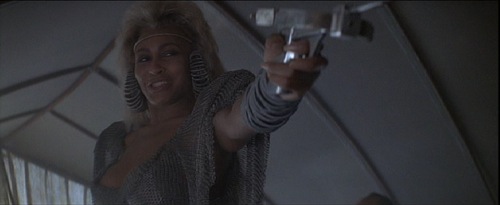 Mad Max Beyond Thunderdome excels on its Warner Bros. Blu-ray transfer. This is by far the best-looking of the three films on hi-def, although some of this can be attributed to the condition of its source: this movie had the largest budget of the series. Dean Semler’s splendid photography is captured with rich natural hues and film grain, and the improved stock from when he shot The Road Warrior means the nighttime and underground scenes have discernible detail, rendered crisply on the disc.
Mad Max Beyond Thunderdome excels on its Warner Bros. Blu-ray transfer. This is by far the best-looking of the three films on hi-def, although some of this can be attributed to the condition of its source: this movie had the largest budget of the series. Dean Semler’s splendid photography is captured with rich natural hues and film grain, and the improved stock from when he shot The Road Warrior means the nighttime and underground scenes have discernible detail, rendered crisply on the disc.
And the sound quality: pow! The movie was originally released to select theaters in a 70 mm blow-up with six-track stereo sound, and the new DTS Master Audio 5.1 mix gives Beyond Thunderdome the full throaty roar it deserves from those multiple tracks. The soundtrack is especially well served: Maurice Jarre’s sweeping score — which has definitely grown on me after initial hesitation — and the two Tina Turner songs, “One of the Living” and “We Don’t Need Another Hero (Thunderdome)” billow out into the sonic space. But the best part of the new sound mix is clarity in the dialogue between the children. I’ve previously found them difficult to understand, and not only because they speak in specialized argot. The DTS-MA fixes this, and now listeners can focus exclusively on the children’s unusual words instead of struggling to hear the words at all.
The downside to the Blu-ray is a lack of supplements. A trailer, that’s all we get. None of Warner’s previous DVD releases contained any bonuses, so this isn’t a surprise. It would be nice to have the two Tina Turner music videos, but apparently there are rights issues involved there.
The fourth Mad Max film, Mad Max: Fury Road, with Tom Hardy taking over the title role, wrapped principle photography in the Namib Desert in December, ending ten years of punishment from some god whom George Miller ticked off. (Oh, it was frustrating.) The new film will probably premiere in 2014 — and then Mad Max Beyond Thunderdome will no longer be “the last movie of the series,” and even those who don’t like it will be unable to call it “the disappointing conclusion.” It will be interesting to see if views of Beyond Thunderdome continue to evolve — up or down — after Fury Road burns rubber.
Oh, I prefer the song “One of the Living” over “We Don’t Need Another Hero.” Because we do need another hero. At least more Mad Max.
It would be morally wrong of me not to include the classic Mystery Science Theater 3000 sketch about “Beyond Thunderdome.”
Ryan Harvey is a veteran blogger for Black Gate and an award-winning science-fiction and fantasy author who knows Godzilla personally. He received the Writers of the Future Award for his short story “An Acolyte of Black Spires,” and his story “The Sorrowless Thief” appears in Black Gate online fiction. Both take place in his science fantasy world of Ahn-Tarqa. A further Ahn-Tarqa adventure, “Farewell to Tyrn”, the prologue to the upcoming novel Turn Over the Moon, is currently available as an e-book. You can keep up with him at his website, www.RyanHarveyWriter.com, and follow him on Twitter.
I’ve always liked this one because Barter Town is such a fun setting and the kids aren’t really played as cloying the way they are in other “kidified” sequels. My friends and I probably quoted from this movie more than either of the other Mad Max movies, despite preferring the first two.
Disappointed to read yesterday that the upcoming Mad Max video game won’t be set in Australia. That’s just wrong.
[…] Mad Max Beyond Thunderdome on Blu-ray […]
Love the history of this movie, caterpillars Mel Gibson acting career.
The kids in this movie made it very special. Like the helicopter guy and his kid, lol, added some humor to their roles.